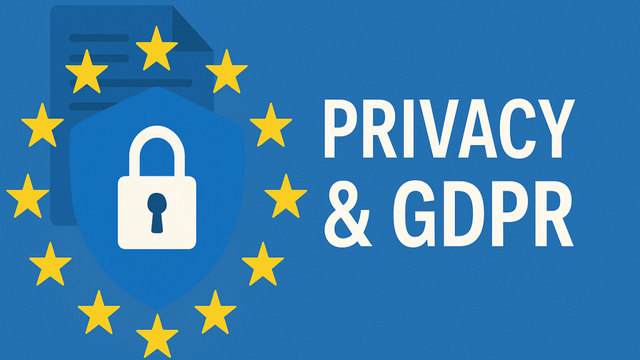GDPR and the Intersection of Security and Privacy | JJ Katz | …corporate Deep Packet Inspection vs: GDPR, reconsidered…
https://alecmuffett.com/article/113527
#DeepPacketInspection #encryption #gdpr #privacy
![image text: Jon muses about whether DPI from a practical perspective is in conflict with GDPR
[more…] image text: Jon muses about whether DPI from a practical perspective is in conflict with GDPR
[more…]](https://s3.eu-central-2.wasabisys.com/mastodonworld/cache/preview_cards/images/064/010/137/original/93f7ae1ace2de017.png)
GDPR and the Intersection of Security and Privacy | JJ Katz | …corporate Deep Packet Inspection vs: GDPR, reconsidered…
https://alecmuffett.com/article/113527
#DeepPacketInspection #encryption #gdpr #privacy
![image text: Jon muses about whether DPI from a practical perspective is in conflict with GDPR
[more…] image text: Jon muses about whether DPI from a practical perspective is in conflict with GDPR
[more…]](https://s3.eu-central-2.wasabisys.com/mastodonworld/cache/preview_cards/images/064/010/137/original/93f7ae1ace2de017.png)
GDPR and the Intersection of Security and Privacy | JJ Katz | …corporate Deep Packet Inspection vs: GDPR, reconsidered…
Jon muses about whether DPI from a practical perspective is in conflict with GDPR
With web proxying, filtering, deep-packet inspection (or SSL inspection) and other tools a well-equipped SOC will be able to see everything, even the content of a user’s https sessions. And even though most Acceptable Use Policies (AUPs) prohibit personal use of work equipment, we all check our personal e-mail, make our doctor’s appointments, and browse Reddit on the corporate laptop.
https://www.linkedin.com/pulse/gdpr-intersection-security-privacy-jj-katz-qv2gc

Network-Detection and Response integriert in der Firewall
#Cybersecurity #Cybersicherheit #DeepPacketInspection #Firewall #NDR #NetworkDetection @Sophos @Sophos_Info
https://netzpalaver.de/2025/06/03/network-detection-and-response-integriert-in-der-firewall/
Решаем проблему «деградации» YouTube с помощью NoDPI
#nodpi #youtube #unblock #DeepPacketInspection #deep_packet_inspection
NoDPI - это программа, которая играет роль локального прокси-сервера. Она обрабатывает проходящий через неё трафик таким образом, что это позволяет сбивать с толку системы DPI, установленные у провайдера. Отлично справляется с "разблокировкой" всех сайтов, к которым ограничен доступ с помощью DPI.
Исключения:
- сайты на HTTP (незащищенном протоколе),
- сайты не поддерживающие TLS v1.3,
- сайты, заблокированные по IP-адресу.
Исходный код, бинарники, подробная инструкция по запуску:
https://github.com/GVCoder09/nodpi/
https://github.com/hufrea/byedpi - аналог на C
Cloudguard von Check Point in der Nutanix-Cloud-Platform integriert
#CheckPointSW #Cloud #CloudPlattform #Cloudguard #Cybersecurity #DeepPacketInspection #Multicloud #NetworkSecurity #Netzwerksicherheit #Nutanix #NutanixCloudPlatform
Lancom ergänzt Firewall-Portfolio mit neuem Flaggschiff UF-1060
#Cybersecurity #DeepPacketInspection #Firewall #ITSecurity #ITSicherheit @lancom_systems #MachineLearning #Sandboxing #UnifiedThreatManagement
https://netzpalaver.de/2024/10/23/lancom-ergaenzt-firewall-portfolio-mit-neuem-flaggschiff-uf-1060/
What is deep packet inspection?
DPI is often used to block malware, but can affect how your VPN works
https://www.tomsguide.com/computing/vpns/what-is-deep-packet-inspection #cybersecurity #DPI #DeepPacketInspection #VPN
Armis verdoppelt seine wiederkehrenden Umsatz in weniger als 18 Monaten
@Armis #ArmisCentrix #AssetIntelligence #Cybersecurity #DeepPacketInspection #Security #SoftwareasaService #ThreatIntelligence
[en] Paper "OpenVPN is Open to VPN Fingerprinting"
"... certain governments are attempting to restrict VPN access by identifying connections using ... DPI technology."
"To investigate the potential for VPN blocking, we develop mechanisms for accurately fingerprinting connections using OpenVPN ..."
Detecting fully encrypted traffic via entropy measurements: when being too random is itself a fingerprint
#DeepPacketInspection #usesec23
"How the Great Firewall of China Detects and Blocks Fully Encrypted Traffic"
https://www.usenix.org/system/files/sec23fall-prepub-234-wu-mingshi.pdf
Music mood: TFW You're on a school/office/campus network that only allows "web" traffic but you run your ssh server at home on port 80, so you can tunnel out to whatever you want.
#music #modularsynth #http #ssh #tunneling #firewalls #deeppacketinspection #networking